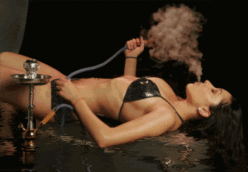As prevalent in parts of the Middle East and India as delis or Starbucks are in the United States, with one on every corner, hookah lounges and hookah bars, once quite rare in the West, have lately been seeing a rise in popularity here. From the friendly ambience of many of these establishments to the uniquely relaxed mood of hookah smoking and the kid-in-a-candy store variety of flavorful tobaccos available, hookah lounges and bars have a lot on offer.
Much of this upsurge in popularity is due to college and university populations, who find hookah lounges an attractive way to spend quality time with friends in a sober, but socially easy, environment. Hookah lounges are big with sororities and fraternities, but there are older sets of patrons on the scene as well, and a multiplicity of ethnicities and people from all walks of life can be found in various hookah lounges.
Different hookah bars and lounges offer different things to go with the smoking experience. At some lounges, an older clientele comes to play cards, backgammon, or chess, while pool tables, video games, and big screen TVs are on offer for the younger crowd. Many lounges serve food and drink, from Turkish coffee, spicy chai, and honey-drenched bamieh fritters to foie gras and Moroccan spiced lamb, while hookah bars offer everything from wine and cocktails to package deals–including private booth or lounge, hookah, drinks, and appetizers–which run about $125 for four. Rental prices for hookahs in lounges generally run from $5 to $20 an hour, with tobacco prices from $4 to $9 per bowl. Whatever’s on offer, people feel comfortable enough to linger, gathered round the hookah pipe. You can find directories of hookah lounges in the U.S., Canada, and Europe at www.hookahforum.com or www.hookahculture.com, and other sites online.
Someone on staff–often the proprietor–is always happy to help those new to the experience of hookah smoking and guide them through it. Pipes are generally prepared for the patrons with whatever exotic flavor of tobacco they choose. There’s usually a hookah coal carrier, circulating through the lounge with coals and tongs to replenish any waning hookah coals.
Music ranges from jazz to hip hop to tablah-backed Middle Eastern pop music, d?©cor from re-interpretations of a Cairo caf?© to tiki hut to sophisticated bar. Whether the people come to play games, drink cardamom-infused coffee, sip cocktails, or just kick back and relax, hookah lounges and bars offer a unique multicultural take on an age-old tradition.
